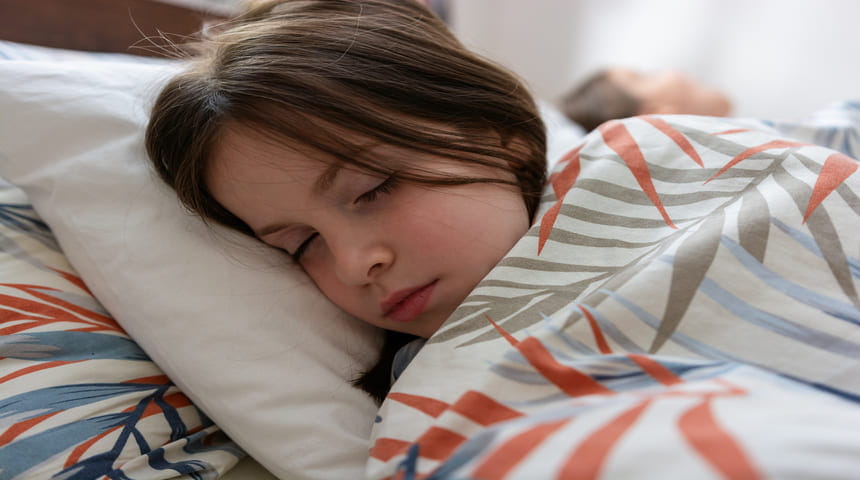The frustration of trying to get your child to go to sleep and stay asleep is something most parents share. But no matter your child’s age, it’s worth the effort.
Is Your Child Sleeping Enough?
Sleep is essential for your child’s physical and mental health. It is the time when kids consolidate what they learned throughout the day, and it helps them retain information and process new skills. It even affects long-term prevention of many diseases. If your child is experiencing any of these behaviors, it may be a sign they are not getting enough sleep:
- Loud snoring
- Gasping for air
- Breathing pauses during sleep
- Restlessness during sleep
- Difficulty concentrating
- Hyperactivity
Common Sleep Disorders
You may be surprised to learn that some of the same sleep problems that affect adults, such as sleep apnea and insomnia, can happen with children, too. Obstructive sleep apnea is the most common sleep disorder, affecting as many as 4 percent of kids. Difficulty falling asleep or staying asleep, known as sleep onset insomnia and sleep maintenance insomnia, respectively, can occur in children, as well.
If your child has enlarged tonsils or large adenoids, they are more at risk for sleep apnea. Adenoid tissue is located deep within the nasal passages, and the adenoids and tonsils can swell in some children. This causes the characteristics of sleep apnea like snoring, gasping for air while sleeping and unrefreshing sleep. Sleep apnea is the most prevalent in children ages 2 to 8, which coincides with the adenoid and tonsillar tissue growth period. But your teenager also may experience sleep apnea, especially if they are overweight or obese. Some studies have shown this time in childhood to be another peak time for sleep apnea.
If your child worries excessively or has poor sleep hygiene, they may be at risk for insomnia. Just like adults, when children lie down to sleep, it’s often the first opportunity to replay the day’s events and plan (or worry about) the following day. Insomnia can be a problem at any time in childhood. Toddlers sometimes have behavioral insomnia of childhood, which usually means that they are resistant to going to sleep because they want to be with their parents or doing anything more fun than sleeping. Older children and teenagers are more likely to be unable to fall asleep due to anxiety or stress in their lives. Teenagers also naturally have a delayed circadian rhythm compared to younger children and adults, which explains why they prefer to stay up later than the rest of the family.
Creating a Healthy Sleep Environment
A healthy sleep environment looks and feels different for each child because sleep is a personal journey. What works for your child may not work for other kids. Generally, you should limit your child’s access to TV, phone and tablet after sunset, because they all emit blue light that activates your child’s brain and makes it less ready for sleep. While some kids do well with quiet environments, other children sleep well with gentle white noise.
One of the most important factors for good sleep is keeping a consistent schedule and bedtime routine. This allows your child to get the recommended duration of sleep each night:
- 11 to 14 hours for children 1 to 3 years old
- 9 to 13 hours for kids ages 3 to 13
- 8 to 10 hours for teenagers
Toddlers should have a routine that encourages physically winding down, such as reading a bedtime story or taking a warm bath, for at least 15 minutes before bed. Older children can read, draw or write in a journal.
Does Your Child Need a Sleep Study?
If you are concerned about your child’s sleep, talk with your pediatrician or visit a pediatric sleep specialist. This is important because sleep is so essential to your child’s growth and development. Based on the consultation, a sleep study may be ordered.
A sleep study involves overnight monitoring of your child’s oxygen, breathing pattern, leg movements and other observations. Sleep studies are noninvasive, easy to perform and can provide important information that guides a child’s care. They help physicians determine whether snoring is normal (physiologic) or associated with sleep apnea that would benefit from treatment. They provide information about how safe your child’s sleep is. There also are special studies that can evaluate your child for narcolepsy and related disorders.
At-home sleep testing is available for some patients, which is a convenient option for children. They can sleep in their own beds and still have a high-quality test for breathing issues.
Choose to Stay in Touch
Sign up to receive the latest health news and trends, wellness & prevention tips, and much more from Orlando Health.
Sign Up










